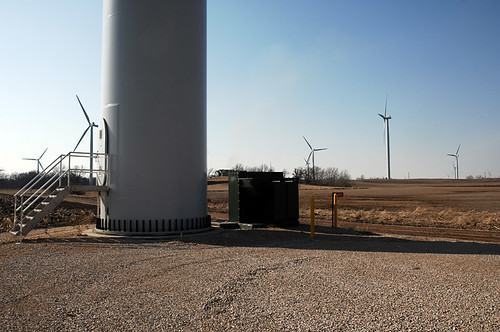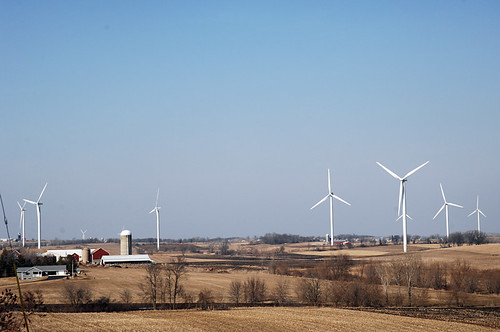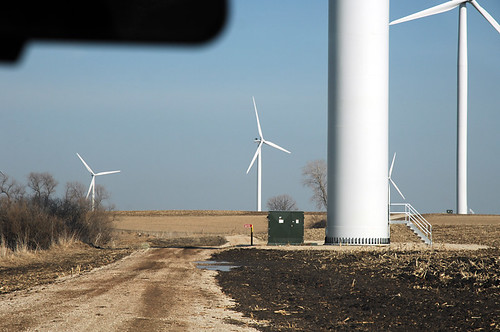Wind school. Placing vertically aligned turbines closer together gives more wattage for the buck.
Credit: Mariah Power
Posted on 11/25/2009 9:23:06 PM PST by neverdem
Wind school. Placing vertically aligned turbines closer together gives more wattage for the buck.
Credit: Mariah Power
Arranging wind turbines like a school of fish could reduce the amount of land they take up by 100-fold while maintaining their electrical output, say researchers. Wind farms based on the approach might also be considerably safer for migrating birds.
Whether it's Lance Armstrong bicycling behind his teammates in the Tour de France or a storm of fish slicing their way through the ocean, animals benefit from drafting. The leader breaks through the calm air or water, while the followers enjoy the reduced resistance in the leader's wake.
The same doesn't hold true for horizontal-axis wind turbines(HAWTs), the most common kind of windmill. Placing one HAWT in another's draft drastically reduces the efficiency of the trailing windmill. That's because the turbulent breeze created by the leading turbine's blades can't propel the trailing blades as well as an unobstructed airflow. So engineers spread the giant fans across hundreds of hectares of land--a practice that has created a backlash from people who find the turbines unsightly.
Turn a windmill on its side, so to speak, and the drafting benefit returns. That's what two fluid dynamicists from the California Institute of Technology in Pasadena have discovered. Robert Whittlesey and John Dabiri decided to study how a new type of generator, called a vertical-axis wind turbine (VAWT), stacked up against its more conventional counterpart. VAWTs resemble giant versions of the lawn ornaments that gardeners install to scare away birds and other veggie-loving critters (see picture). The researchers measured airflows at a prototype VAWT array in Glendora, California. They then compared that data with existing studies of how water flows through schools of swimming fish to see how geometrically arranging the arrays affected their performance.
Bunching up the vertical-axis turbines behind a leader pays off, Whittlesey and Dabiri reported yesterday at the annual meeting of the American Physical Society in Minneapolis, Minnesota. In fact, using a new mathematical model they developed from the Glendora data, the researchers found that arranging the VAWT arrays just like schools of fish produced the best results. Such tightly packed VAWT arrays can produce as much electricity as conventional windmills, all while using as little as one-hundredth of the land area. "I don't think I expected to see as great an improvement in the land use," says Whittlesey.
The study revealed that the most efficient arrangement involved alternating the rotational direction of the turbines: a clockwise rotation in the lead turbine, say, with two counterclockwise rotators next in line, followed by three clockwise rotators, and so on. Whittlesey notes that the models are preliminary, so even greater improvements might be possible with further study. And he says that the VAWT arrays could be much less deadly to birds because "the faster they spin, the more solid they appear," thereby allowing birds to see the turbines more easily and navigate around them.
The study shows "great promise," says mechanical engineer Lex Smits of Princeton University. Even if VAWT configurations achieve only half of the land-use gain as suggested, he says, "it would be a major improvement."
I suspect that the turbines would have to be closer together than those in the photo for drafting to have much effect. But I could be wrong.
For U.S. Military, More Oil Means More Death
It's not efficient when the "fully burdened" cost is $45 - $400 per gallon for generators?
The other scenario I wonder about is our grids getting fried with an EMP attack. Wouldn't dispersed renewable energy make sense just for personal or local consumption?
The Betz proof is good for comparing one wind use design to another, but it’s irrelevant where building a turbine on a given site for energy is concerned. For me, it all comes down to dollars spent per wattage produced.
Thus, the paradox that wind energy is more cost-effective in my area (windy much of the time) than solar energy and far more cost-effective than propane or electricity (propane racket and no nearby grid power).
Feast your eyes on the information behind the link below, if you’re really analytically interested in wind energy and not subjectively attached to another pecuniary/political interest. Although we also use PV supplies (good during the few warmer months), the following is the most efficient (dollars/watts) in my area. And BTW, due to cost-saving measures by the commercially built wind turbine manufacturers (magnets, coils and hubs too weak), commercial turbines burn up here.
http://www.otherpower.com/otherpower_wind.shtml
I can build a 10-footer, including tower, permits and electronics for ~ $1200 to get an average of about 450 watts (about 700 tops from minute-averages) in a typical winter wind here. ...a 17-footer costing me about $5000 to build for about 1.5 kilowatts (about 3k tops from minute-averages) in typical winter winds. And those are rated much more conservatively and honestly than the machines built by the corporates.
For the mostly un-windy and un-sunny areas of the eastern lowlands...start burning fecal and other rotting matter for alternative energy, if you like. But don’t try to further regulate against the building of what works in windy and sunny parts of the West.
Maybe Obama will just send them along thier way with wind propelled beanies and solar powered HUMMVEES
Its not feasible and you know it
Or, make each turbine individually reversible and control that feature remotely with a computer so you could automatically select the optimum arrangement of clockwise-counterclockwise rotation.

 My understanding is that it is real-time energy all the time. Nothing is stored. On top of that, when the blade turbines don't have enough wind to turn them, they rely on electricity to turn them. How crazy is that? Plus, they are an eyesore. Learn more about turbines at Wind Action
My understanding is that it is real-time energy all the time. Nothing is stored. On top of that, when the blade turbines don't have enough wind to turn them, they rely on electricity to turn them. How crazy is that? Plus, they are an eyesore. Learn more about turbines at Wind Action

These access roads need to be kept cleared during the winter so that the turbines can be checked on when needed. So a snow plow has to go out and clear the access road each time it snows. The generator is on the left.
Alright, for the sake of argument, assume this might be true. Now how does that compare with the watts/acre for nuclear?
Silly me, I thought that money was to create jobs in America.
And then they have to be shipped across the ocean. Those things are humongous...that must be quite a bill - and a massive amount on energy for such shipping.
All a massive scam.
The Washington pols have been playing footsie under the table with China for decades now. And alGora is a master player. I'd like to see him go down but if there is a real investigation and heads start to roll - re the phony data on climate control - he'll throw everyone else under the buss. I just want to live long enough to see him get his just deserts. Evil personified.
Wind turbines get the largest chunk of tax dollar support among all alternative energy scams, er, sources.
See the link in comment# 22. I'm thinking about their utility off grid in remote locations, e.g. forward operating bases. What good is nuclear if your grid is fried in an electromagnetic pulse attack?
Be that as it may. An old Westinghouse plant, built in '72 to make gas turbines, which later made big electric motors, but is now Teco-Westinghouse (TECO is a Taiwan company) is building them just north of Austin.

These are not tiny turbines either.

at any given moment, a minimum of 10 % of the wind machines are idle. They don’t work in a sustained manner.
This means you can take the maximum out put and deduct 10-20 % for out of service.
This statement is bases on firsthand witness of hundreds and hundreds of the machines in Texas, Colorado, Wyoming and Idaho. I actually made counts of those operational and idle
Disclaimer: Opinions posted on Free Republic are those of the individual posters and do not necessarily represent the opinion of Free Republic or its management. All materials posted herein are protected by copyright law and the exemption for fair use of copyrighted works.